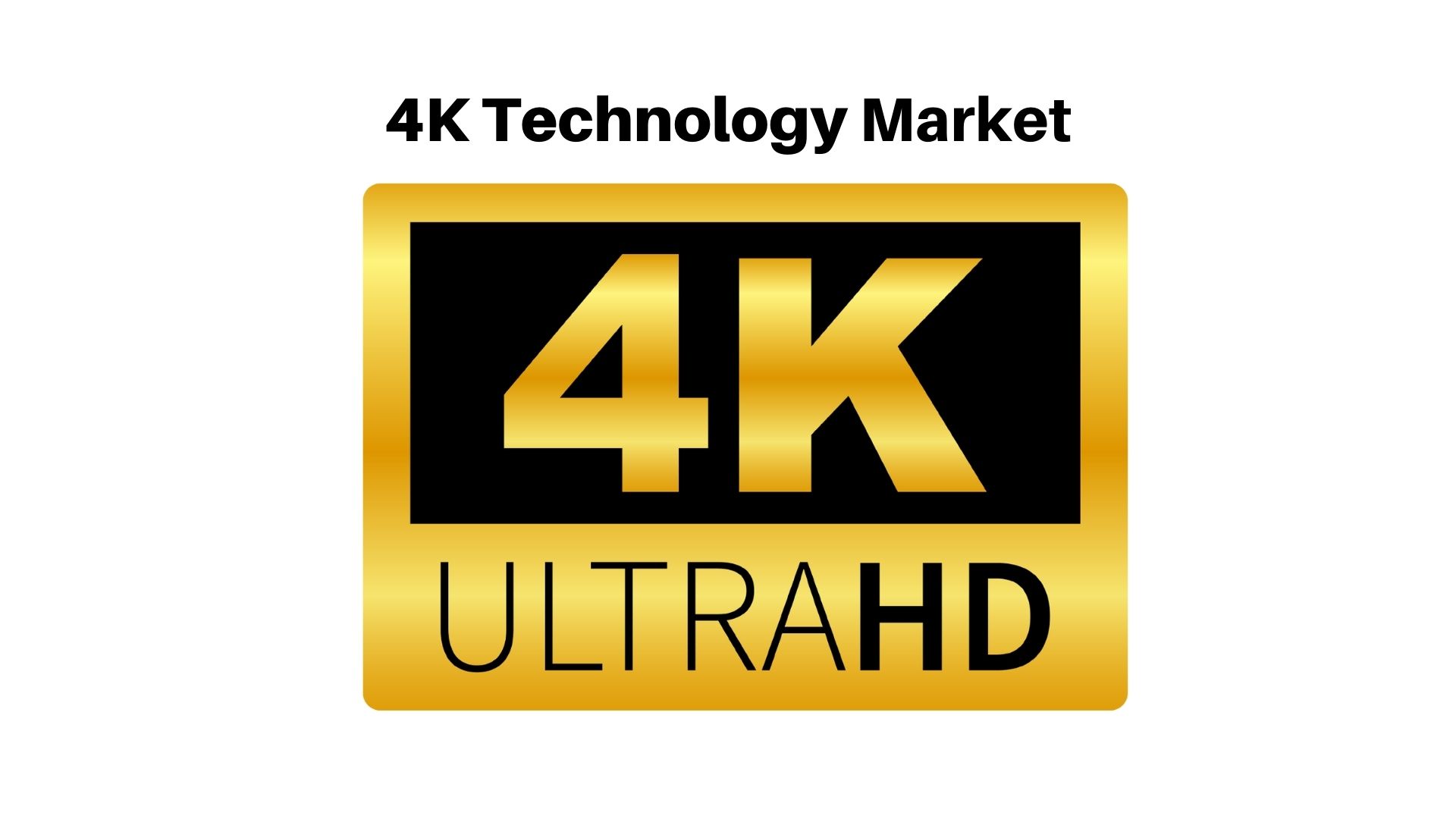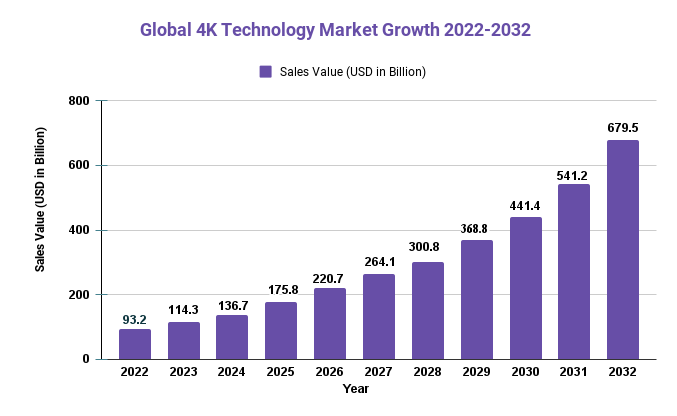4K Technology Market Report Offers In-Depth Analysis + Growth Rate 22.6% by 2032

Page Contents
Market Overview
Published Via 11Press: The global 4K technology market is anticipated to experience strong growth over the forecast period, spurred by increasing demand for high-resolution displays, rising adoption of 4K technology in entertainment industries, and rising awareness about 4K technology among emerging economies. By 2032, analysts project that this size will have doubled from USD 93.2 billion in 2022 to USD 679.5 billion at a Compound Annual Growth Rate (CAGR) of 22.6% during this time.
In recent years, the 4K technology market has experienced rapid growth due to rising demand for high-quality video content and improvements in display technology. Forecasts predict that this growth rate will continue over the coming years.
4K technology refers to displays and content with a resolution of at least 3840 x 2160 pixels, four times that of traditional 1080p HD displays. This provides sharper, more detailed images suitable for various applications such as televisions, computer monitors, gaming systems, and professional video production. One major driver in the 4K technology market is an increase in 4K content availability such as movies, TV shows, and streaming services.
Request For Sample Report Here: https://market.us/report/4k-technology-market/#requestSample

Key Takeaways
- The global 4K technology market is anticipated to experience a compound annual growth rate (CAGR) of around 22.6% during the forecast period.
- The entertainment industry is anticipated to be the primary end-user for 4K technology.
- North America is anticipated to hold the largest market share, followed by Europe and Asia Pacific.
- Key players in this market include Samsung Electronics, LG Electronics, Sony Corporation, Sharp Corporation, and Panasonic Corporation.
Regional Snapshot
North America is expected to hold the largest market share due to the presence of major players and the increasing adoption of 4K technology in the media and entertainment industries. Europe follows, driven by high-resolution display demand in that region. Asia Pacific region also sees significant growth due to the increasing adoption of 4K technology among emerging economies such as China and India.
Drivers
- Demand for high-resolution displays across various industries
- Growing adoption of 4K technology in entertainment
- Enhancing viewing experiences at sports and live events
- Technological advances in display technologies.
- The global adoption of 4K technology is increasing, particularly in emerging economies.
Restraints
- High cost associated with 4K displays
- Limited availability of 4K content
- Inadequate infrastructure in certain regions
- The slow adoption rate in certain industries and segments.
Opportunities
- High-quality display screens are becoming more and more in demand across various industries such as entertainment, sports, education, and healthcare.
- 4K resolution has become increasingly popular with consumers due to its superior viewing experience – leading to an uptick in 4K television and monitor sales.
- Recent advances in 4K technology, such as HDR (High Dynamic Range) and WCG (Wide Color Gamut), have further enhanced image quality to make it more captivating to consumers.
- The development of new applications such as virtual reality and gaming that require high-resolution displays have created new prospects for 4K technology.
Challenges
- The high cost of 4K technology compared to traditional displays can limit its adoption in certain industries and by consumers with tight budgets.
- Limited availability of 4K content may further deter some consumers from choosing this display type.
- The need for powerful hardware to run 4K content smoothly can drive up the price tag associated with owning a 4K display.
- Furthermore, there is the risk of obsolescence as technology develops, potentially leading to even higher-resolution displays in the future.
Recent Developments
- 8K technology was recently developed, offering higher resolution than 4K at an increased cost.
- Additionally, 4K displays now incorporate AI technology for enhanced image quality and features such as upscaling lower-resolution content into 4K resolution.
- The increasing availability of 4K content from streaming services such as Netflix and Amazon Prime Video, along with the release of 4K Blu-ray discs, points to its growing adoption within healthcare for medical imaging purposes.
View Detailed TOC of the Report: https://market.us/report/4k-technology-market/table-of-content/
Key Market Segments
Type
- TV
- Camera
- Digital signage
Application
- Television and Consumer Media
- Movie Projection
Key Market Players
- AsusTek Corp
- Samsung Electronics Corp
- JVC Kenwood Corp
- Hisense
- Sharp
- LG Electronics
- Hong Kong Skyworth Digital Holdings Ltd
- Innolux Corp
Report Scope
| Report Attribute | Details |
| The market size value in 2022 | USD 93.2 Bn |
| Revenue forecast by 2032 | USD 679.5 Bn |
| Growth Rate | CAGR Of 22.6% |
| Regions Covered | North America, Europe, Asia Pacific, Latin America, and Middle East & Africa, and Rest of the World |
| Historical Years | 2017-2022 |
| Base Year | 2022 |
| Estimated Year | 2023 |
| Short-Term Projection Year | 2028 |
| Long-Term Projected Year | 2032 |
Frequently Asked Questions
Q: What is 4K technology?
A: 4K displays boast a resolution of approximately 4,000 pixels, providing much sharper detail and clarity than traditional displays.
Q: How does 4K technology differ from HD?
A: 4K displays offer a much higher resolution than HD displays, providing viewers with more detail and clarity in their images.
Q: Which industries are adopting 4K technology?
A: 4K is being adopted across many sectors, such as entertainment, sports, education, healthcare and gaming.
Q: Can I watch regular HD content on a 4K display?
A: Most 4K televisions are capable of upscaling lower resolution material to 4K resolution, though quality may not match that of native 4K content.
Q: Is 4K technology costly?
A: No, 4K displays tend to be more costly than traditional displays; however, prices have been declining as this technology becomes more widely adopted.
Q: What is the difference between 4K and 8K technology?
8K technology offers even higher resolution than 4K, creating images with even sharper details, but at a higher cost.
The team behind market.us, marketresearch.biz, market.biz and more. Our purpose is to keep our customers ahead of the game with regard to the markets. They may fluctuate up or down, but we will help you to stay ahead of the curve in these market fluctuations. Our consistent growth and ability to deliver in-depth analyses and market insight has engaged genuine market players. They have faith in us to offer the data and information they require to make balanced and decisive marketing decisions.